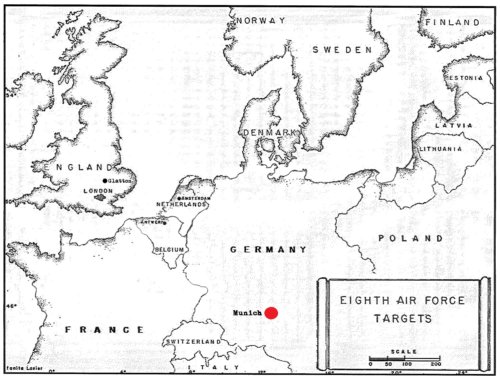TARGET: ALLACH AERO ENGINE WORKS
MUNICH, GERMANY
16 JULY, 1944

Munich, having received a two-day respite, was the objective for the fourth time in six days of the striking power of American heavy bombers. The field order was the same as before. Bomb Allach if weather permits. Bomb Munich if clouds obscure the ground.
The 457th Group dispatched thirty-six planes aloft to comprise the lead and low boxes of the 94th A Combat Wing, with Major Hozier and Lt. Russell M. Selwyn leading in a PFF plane. Major Dickinson led the low box. After a normal assembly, the formation, sixth in the Division line, proceeded across the North Sea to the Scheldt Islands. Again no variation or deception had been put in the penetration route. It was exactly the same as the last three missions.
The flight south over Belgium and thence southeast over northern France, Luxembourg and Germany, to a point fifty miles from the IP was uneventful. The cloud cover increased to ten- tenths near Stuttgart and rose abruptly from 14,000 to 22,000 feet. Dense and persistent contrails interfered with the formation flying. The Division formation became disrupted. A turn northeast was executed to hold it intact.
The IP was far to the south as it was passed, still the course was held although Munich was fifty miles to the south. Finally, when a turn was made for a run on the city, Regensburg lay directly beneath the thick clouds which now had risen to 26,000 feet. The bomb run would be from the northeast instead of the northwest. The bombs were released from 27,000 feet. It was therefore certain that the bombs landed in the center of the city. At this height the flak, though intense, was vely inaccurate. Much of it was a thousand or more feet below.
After bombing, the Wing formation proceeded in the return route by itself. The aircraft returned without loss. Four times in six days southern Germany had borne the weight of more than one thousand American heavy bombers.
